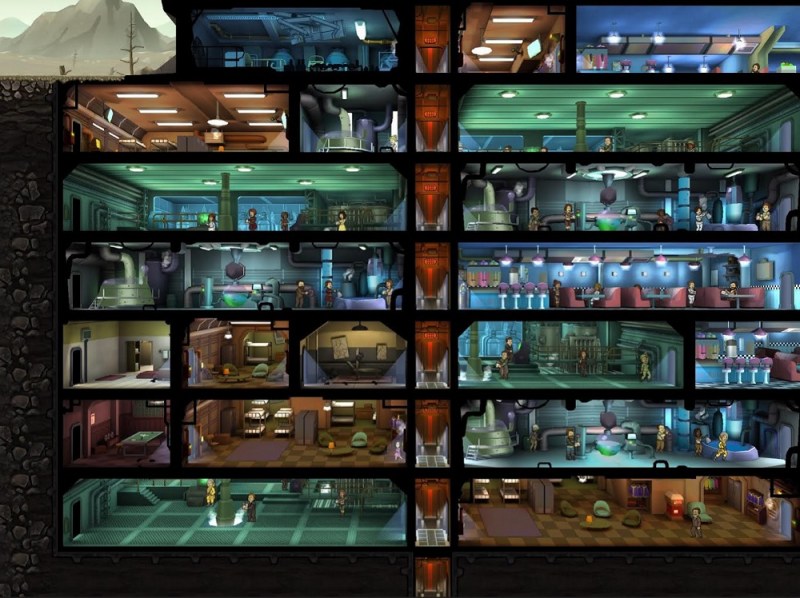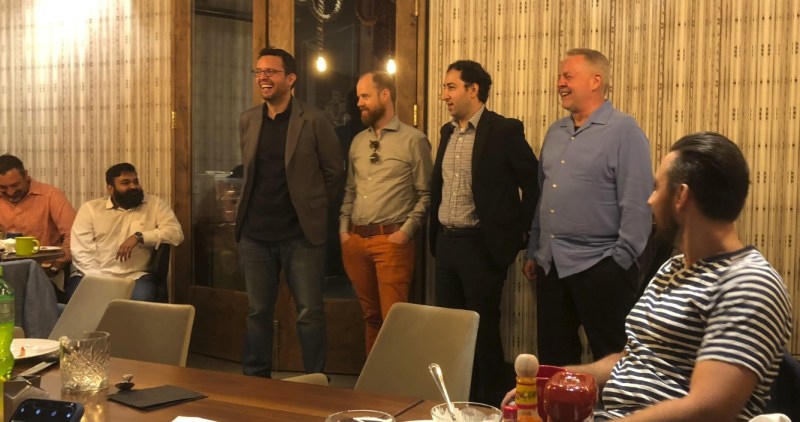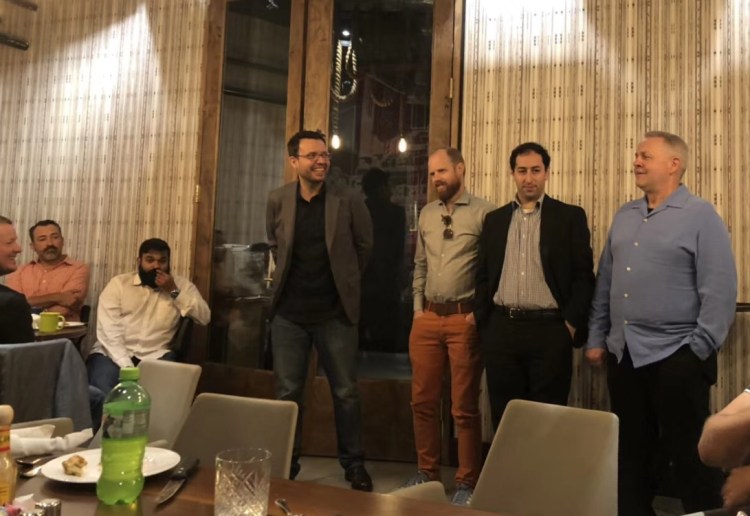
Above: My Vault in Fallout Shelter has some dead bodies in it.
GamesBeat: I think about how E3 is an example of what’s happening with consumer behavior. It used to be a show where you made an announcement and six months later the game came out. Bethesda, back in 2015, announced Fallout Shelter and said, “By the way, you can download this now.” They got 12 million downloads in a day. Thanks to streamers, E3 itself is now getting billions of views in a week or two. That instant gratification is what gamers want now, because they have nanosecond attention spans. We’re heading in this direction toward immediate gratification for consumers, and cloud is something that can deliver that.
Michael Sudin, audience: You guys are talking about the future, but we’re doing this today. You had three questions: price, does it work, and do you have content? The way we’re doing content [at Blade Shadow] is we’re giving you a Windows PC. Working with Microsoft, we have licenses, and you can install whatever you want to play. If you want to play Fortnite, free-to-play games, go for it.
Tops: What’s your price point?
Sudin: $35 a month.
Tops: $35? I’m not even subscription. If I can do that in the cloud….
Rodriguez: Aren’t we talking about two different things here, though? One is a delivery technology and one is a business model. We should keep things straight here. Let’s talk about a delivery mechanism, a replacement for discs, or let’s talk about a business model. They’re not the same thing.
Sudin: $35 buys you a really powerful PC and the cloud. That’s what we give you. You can play the latest game that comes out tomorrow, use apps today, or whatever you want. You have content.
Navok: For you, the consumer decides between buying a $400 console, or a $1,000 PC, or a $35 per month service. Each one of those gives them access to play their games.

Above: Cloud gaming panelists (left to right): Nelson Rodriguez of Akamai, Doki Tops of Utomik, Jacob Navok of Genvid Technologies, and Chris Early of Ubisoft.
Sudin: In terms of monetization, the reason we can deliver high quality is because we have our own servers. That brings our price point down significantly from other platforms. You can run this on AWS, but it doesn’t have the hardware capabilities. It doesn’t have the optimizations we have. We can get it to work, and we have the price point.
GamesBeat: How do you address a larger part of the market? You can find a niche and build a startup there, but how do you reach the scale where people are going to care about it?
Sudin: Today we’re going after the high-end gamer. We have to win over those influencers, those core gamers, and change the mentality. We started with a skeptical view here today. The most frequent question we have on our website is, “Does it work?” People want to buy it.
Early: One of the things you’re getting at is the cost of service, when you think about games. Your cost to serve to the player is $35 a month, arguably plus some amount more, from an overall standpoint. The better companies get at providing the capability to run that, the more market that opens up. Right now, today, the person deciding, “Hey, maybe I will play Assassin’s Creed again,” because they enjoyed the first one and then they had kids or whatever — I think it’s a price question too. There’s obviously price elasticity in the market. If you can drive your costs down to $5 a month, I have a much larger market that would very much appreciate it.
Audience: Right now that price point is for the high end. Those cards are going to get old. We have excess capacity during the day. We don’t necessarily have to hand you a new graphics card every time you log on, but we do today. All of these things can be optimized. Today we’re trying to get a foothold in the market, expand, build a brand, and then do all of those optimizations. They’re completely possible and they can drive our costs far down, especially if you’re playing older games, or just doing something like word processing.

Above: You can use the Shadow device to log into the Shadow cloud gaming service.
Rodriguez: If you can get to the point where you’re dynamically allocating a server or a computing device in the cloud, you could lower the cost to serve that. Other folks are doing that too. GeForce Now is out there with their systems and things like that. That’s great. So why aren’t people all over it?
Tops: We have our own delivery model, which also gives instant gratification on a connection that also runs cloud games. That’s a funny thing. I’m a bit of a schizo here. I have technology that just uses the compute that’s available, the compute people have in their pockets. It’s insane, right? It’s double a PS3 now. That’s why PUBG can run on all these systems. I’m just looking at a place like, where do I need it? Where can I use it? There are instances where I can use this compute and still give an instant gratification solution.
My view of it is the costs are real. I’ve been doing modeling on this business every year. Every year I say, “Let’s do it again. Let’s do it again.” I want it. I might sound negative, but I want this to work.
Rodriguez: Right, because you offer a great thing. You offer a subscription business model at a very short wait time to be able to play.
Tops: Right. I want to keep that price reasonable. The $5 mark, that’s a magic mark. When I talk to these guys and say, “I have my subscription service, but I’d like to deduct my distribution costs, and I do cloud gaming,” he just runs off into the distance. “Yeah, you can pay for that.” But if I have to pay for that, that’s why all of these services — EA basically bought a negative business. They were not making money. That’s not a good thing for cloud games. I’m trying to figure out models where we can make it work, because the delivery model and the business model, they are connected to each other.
Early: I don’t buy that at all. Right now you can do a subscription business model, download these games — Microsoft has a service just like that. It doesn’t have anything to do with cloud gaming.
Rodriguez: This is why I think they’re related. Microsoft’s Game Pass, Akamai loves that. To download 100,000 games if you want to, and we’ll charge them for it? There’s no way that’s going to be a sustainable price.
Navok: You’re saying replacing a six-gigabyte download with 5Mbps constant for 40 hours is going to result in the same thing.
Tops: This is where it gets broken. I really want to explain to this people. This is where delivery becomes different. If you do cloud gaming, you have 100,000 people online. Those 100,000 people create 100,000 unique streams. This means, inside your entire network, there’s zero caching. All of a sudden you need a pipe that’s 100,000 times 5Mbit. I think 5Mbit is being very positive. High framerate, good fidelity, competitive latency, that’s probably more like 7-12Mbit to get a great experience. Maybe even 15. The pipe that you need, and you actually pay for the pipe—the bandwidth is nice, but if you need a concurrent pipe, it becomes really expensive at scale.
Audience: Parsec is in the cloud gaming business, in that our encoder and streamer powers a cloud gaming service through our business. But we don’t believe that right now is the right time for cloud gaming. The economics do not work. It doesn’t work, because if you want to be playing constantly on this system — for a lot of reasons you said. If you get hundreds of thousands of people on this pipe, it’s a problem. There’s no caching.
But I do think the point you’re making about content is really the most important thing. The best experience is going to be a situation where I’m watching Rogue One and I want to finish Rogue One as a game. The distribution model of cloud gaming will allow for that. Whereas the current model doesn’t it. But we have to get to content like that.
Navok: That’s a very important point, but I want to connect it to the business model question, because the question of profitability and cost here is an equation of what you’re charging the consumer and what they’re willing to pay. If you resolve content that is new, that creates monetization thresholds that are larger, and you’re not destroying value by keeping everything under a cap and setting a premium fixed price, then you will be able to justify the cost.
If you can create whales that are paying you $300 a month for your games — and God knows we’ve read some amusing articles around Final Fantasy Brave Exvius recently, the thousands of people paying thousands of dollars for that mobile title — it’s possible to do this. You’ll be able to generate profit. But I agree that today, the business model and the content model are not being charged at a threshold that can create profitability.
Rodriguez: The way that Nvidia licenses work, generally, is that you can’t use GeForce cards in the cloud.
Navok: That’s partially our fault. I went to Jensen Huang and said we were going to do that, and then they changed the licensing rules.
Rodriguez: You’re against the terms of service unless you have a special licensing agreement with them. If you use P5000s, that’s $6,000 a card or whatever it is, and they have the same output as a 1080. It has to be dedicated to each gamer. The expense….
GamesBeat: We have all these arguments right now about why this may or may not work. But the leaders of the industry are actually starting to communicate that we’re doing stuff here.
Early: For us it’s a question of addressable market. We believe that there are plenty of people who are willing to play the games that we make today if we can deliver it into their hands in a way that they’re willing to pay for. Today, our 150-million customer base buys our games, and as we all know here in this room — we’ve all got friends who stopped playing games because they didn’t buy the last console or didn’t upgrade their PC, who still reminisce about games. We saw that about a game we announced recently where Star Fox is going to be a character. There was an amazing outpouring of nostalgia that created at the press conference. They’re there.

Above: Utomik has 800 titles available for download.
GamesBeat: That’s where we want to get, but is there something that happened to make them less skeptical about this equation that Nelson brought up?
Tops: 60 gigabytes, if you can get it pretty cheap, that’s 30 cents. The distribution costs, cost of deliver, 30 cents, one time only. Versus $35 a month? That’s a gap. It doesn’t need to come to that price, not by a long shot, because there’s other economics there. I think there’s already context in which, for me, cloud gaming is working. Otherwise I wouldn’t be here.
Early: There are more people talking about cloud gaming and the ability for us to create that addressable market, whether it be Microsoft’s service, whether it be your service. The challenge we have is that those are all unprofitable business models for us as a publisher. We have to figure out a way that we can take advantage of that type of distribution or increase in the addressable market. We have to find a way to monetize.
Tops: This is the same challenge that the music business went through, that TV went through, that Hollywood studios went through. It’s a question of, can you go to an all-you-can-eat model and still be profitable? For a while the answer was no, and now maybe it’s yes.
Early: Leaving aside all the differences between video and games, that business started off a lot differently than we’re starting off. That wasn’t a revenue share business. That was a big sack of cash for the rights to show your content for a certain amount of time. We’ve been motivated by big sacks of cash before. If you watch that progression with Netflix, it started off in the millions, then the tens of millions, then the hundreds of millions. Then there were billion-dollar deals. Now they make their own content.
Nobody is offering us a billion dollars for our content yet. We might be part of some subscription service. Anyway, the challenge comes back to, is there a way we can take cloud gaming’s benefits, extract the concept of subscription from that, or figure out a way we can make money with subscription, neither of which we’ve seen yet. But more people are talking about it. More big players are talking about it. There’s going to be a bit of hope there.
Parsec’s Benjy Boxer: With all these costs and everything like that, you’re right. There are people who are out of the market that want to play games. They have money. That’s who uses — our service is expensive. If you’re going to play cloud gaming on our service, it’s a part of our business, but it’s expensive. People pay a dollar an hour to play on our service. Those people play two or three hours a week, which isn’t that much money to them over a course of a year. You can expand your sales to those people. But if you want to play 10-15 hours on our service, you should just build or buy your own PC.
Rodriguez: We have some OnLive veterans here, and I’d be interested to hear from you, because we’re talking in theory about something you guys have lived through. Do you have any challenges to what you’ve heard, any agreement with what you’ve heard?
Audience: These are all discussions we’ve had since 2008, 2009. I’ve had some of them with Chris. There’s a lot of negative things I could say. There are positive things I could say. The technology works. That was one of the things we heard a lot when OnLive came out — that it’s impossible, that it’s against the laws of physics, all that stuff. It was running for a long time.
The thing you brought up, and that’s a conversation over something that no one’s really solved — you have this concept of the last gamer. There’s this mythical creature out there who used to have a console and then he got married and got a job. He wants to play games, but his wife keeps him down. That’s a very regional look at a customer. It’s very North America-centric. You talk about those 2 billion-plus people, the vast majority of those are not in North America. Content does not work in every single region. To me there are two very important conversations. The bandwidth problem isn’t solved. The bandwidth problem is in the house.
Navok: We had the same problem as you guys, that last 10 feet to the router. With 5G coming out, that will finally start to solve the last 10 feet.
Audience: But then cost starts to go up because you’re streaming 4K content.

